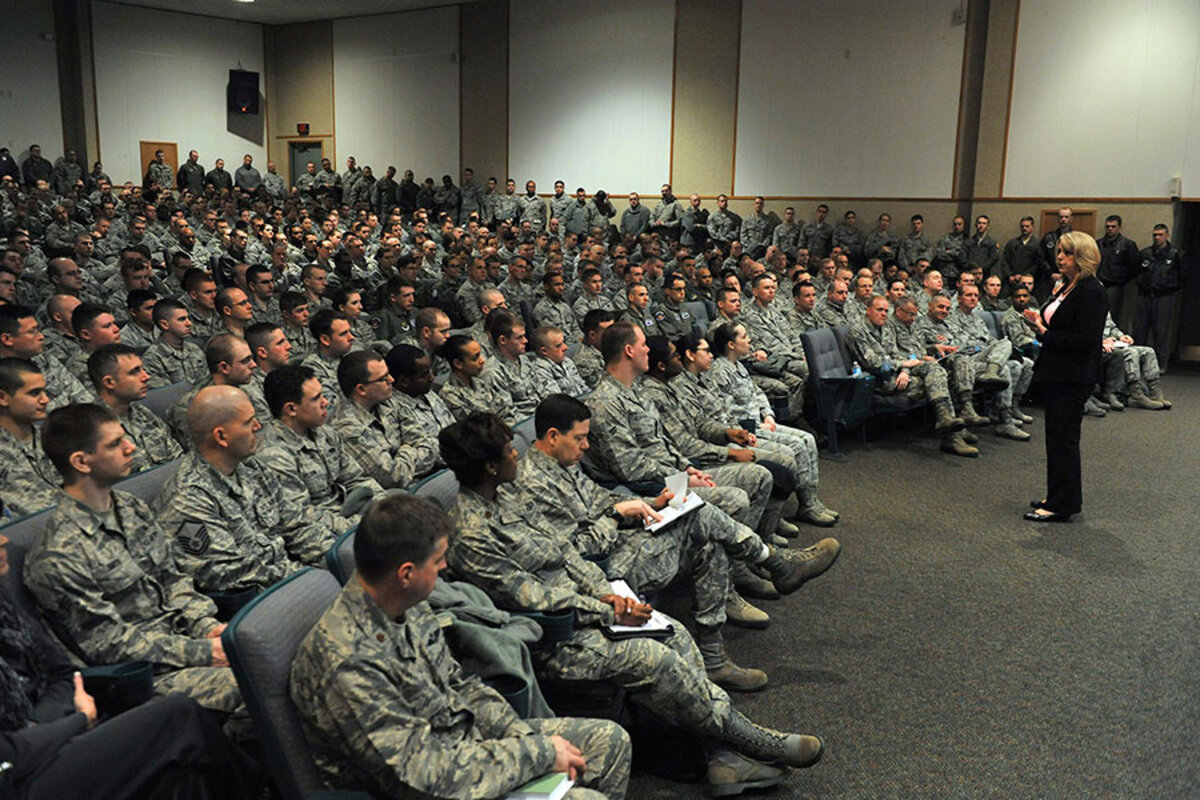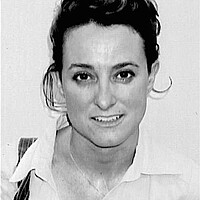Air Force's pioneering approach to diversity
Loading...
| Washington
Air Force Secretary Deborah James can clearly remember the moment she was forced to acknowledge her own unconscious biases about people.
She was asked to look at pictures of two men. “One had tattoos all over his body, huge muscles – the way he was dressed reminded me of a gang person,” Secretary James recalls in an interview with the Monitor. “I thought to myself, ‘Wow, perhaps this is a prison convict.’ ”
The other was a picture of a “clean-cut, attractive man.”
The question: Who would you rather have your daughter date?
“Naturally I and everyone else in the room went for the clean-cut man because of his appearance,” she says.
The tattooed man, it turns out, was the mayor of a very successful small city. The clean-cut man was Ted Bundy, the serial killer.
The moment came during a diversity training session, and this month the Air Force is making them mandatory for all its boards that govern promotion.
The reform speaks to how the Air Force has become the most aggressive military service in addressing diversity in its ranks. From required recruiting goals to more flexible guidelines around maternity leave, the Air Force is adopting policies that, in some cases, put it on a par with companies such as Facebook and Amazon.
To a large degree, the changes are born of necessity. The Air Force is overwhelmingly white and male. Of the Air Force’s 280 generals, 18 are minorities. Of the Air Force’s roughly 9,000 combat pilots – the field from which the service tends to draw its leaders – at least 87 percent are white and nearly 94 percent are men. Overall, the force is 85 percent male.
The concern is not purely about greater gender and racial equality. It is that women and minorities are joining the force but then dropping out at higher rates. That represents not only a loss of investment but also a failure to expand the force’s potential talent pool.
“As a general proposition, we recruit a decent number of women and minorities into the force,” James says. “Where we don’t do so well is that we have women [leave] at mid-career at twice the rate of men.” It’s a similar story when it comes to minorities, she adds. “So we’re losing them at a higher rate. Why is that so?”
How the Air Force is changing
Answering that question has been a central focus of James’s three-year tenure as the service’s top civilian, and it's showing the first signs of bearing fruit.
She first instituted simple changes. She made it easier for people under 5-foot-4 to become pilots. She also required recruiters to start upping the pool of women – from one quarter to 30 percent. Today, the Air Force Academy class of 2020 is up to 29 percent women; for Air Force ROTC programs, it’s up to 33 percent female.
James also required promotion boards for big-deal career jobs – in the military, positions like aides-de-camp and executive officers – to include “at least one qualified, diverse candidate” in the interview pool.
The requirement draws on the National Football League’s “Rooney Rule,” which mandates that the slate of candidates being interviewed for top coaching jobs must include a minority. Similar programs are in place at Facebook and Amazon.
“These are very visible, key developmental positions, so I think sending a signal that this model is out front for different races or ethnicities or genders is important,” says Katherine Kidder, a fellow in the Military, Veterans, and Society program at the Center for a New American Security.
In this regard, the Air Force is leading the way within the Pentagon, she adds. President Obama released a statement last week calling for more diversity in the government, and “the Air Force was right out there with its plan, which we haven’t necessarily seen from the rest of the services,” she says.
The need for such programs was further brought home for James at another diversity training session. Both male and female actors playing the role of job applicants had memorized a script as part of an interview.
“The words they uttered, the background they described was identical,” James says. But focus groups overwhelmingly selected the man, “even though the words out of their mouths were the same.” Similar studies found focus groups tended to consider the men “confident” and the women “conceited.”
In the military, other challenges in getting women into top jobs have arisen, Ms. Kidder says. For example, in an era of intense scrutiny of sexual assault, many senior leaders pass over women as aides-de-camp, since the position includes lots of traveling and closed-door conversations.
Why many women drop out
Then there are hurdles that cause many women to leave the force after only a few years. A primary one is career flexibility.
When the question raising a family comes up, many women will leave, in part because current Air Force rules require them to opt out of their military service commitment before their baby is born.
“This has the effect of requiring women to make a separation choice before childbirth, which may potentially undermine retention of quality airmen,” an Air Force document notes.
Under a new initiative instituted this month, women will have a year after their baby’s birth to decide on their career path, in order “to better understand and assess how they can juggle a military career and family,” the Air Force document adds.
“See how it is before you make such a decision – and oh, by the way, we will match you up with a mentor in the same situation – someone who is doing what you’re about to do,” James adds.
This push for balance can clash with demands for readiness. In August 2015, the Navy expanded paid maternity leave to 18 weeks, which at the time was the Defense Department’s most generous policy and in line with companies like Google. The Air Force and Army were considering similar 18-week paid leaves, but in February Defense Secretary Ash Carter ordered all services to adopt a 12-week policy.
The move sparked disappointment among some, but such leave policies are costly, and the armed forces “have to answer Congress” on their budgets, Kidder says.
In the meantime, the Air Force is looking into not just maternity but “parental” leave, in another effort to help couples share responsibility for child-rearing.
“We are all in a battle for talent,” James says. “If everyone has the same background and experience, you tend to get the same solutions over and over again.”





